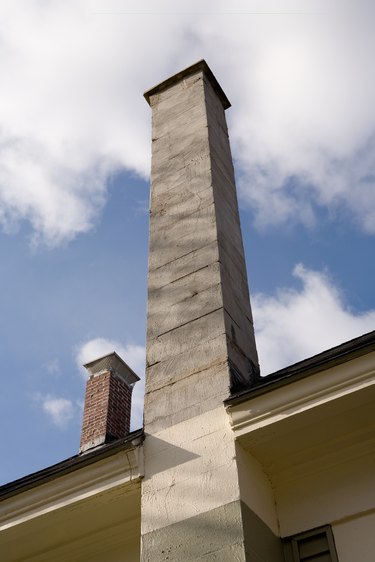Things You’ll Need
-
Drill
-
1/4-inch masonry drill bit
-
Hammer
-
Chisel
-
Reciprocating saw
-
Stove cement
-
Trowel
-
Fire-clay thimble
-
Insulated steel stove pipe sections
 Review local codes for the local safety guidelines of chimneys and stoves. Image Credit: Jupiterimages/Photos.com/Getty Images
Review local codes for the local safety guidelines of chimneys and stoves. Image Credit: Jupiterimages/Photos.com/Getty Images
A fire-clay thimble is simply an insulated sleeve that provides a safe passage for a stove pipe that is penetrating a chimney. Whether your chimney is made out of cement blocks or another material, a thimble is a necessary safety measure for a safe vent connection. Before beginning your installation, make sure all of your materials are approved by the manufacturer of the appliance or stove. Each appliance type has different requirements for safe venting configurations, materials and clearances. Additionally, always review local building codes for the highest level of safety.
Video of the Day
Step 1
Determine where the vent piping should penetrate the chimney. The best way to do this is to set the stove in its intended location and attached pipe sections to flue collar. Review the manufacturer's instructions for proper venting configurations. In many cases, it is best to use a fire-clay thimble for passage through the masonry. Hold the thimble up to the chimney and trace the around the circle with a pencil.
Step 2
Cut an opening in the cement chimney based on the circle you've traced. If possible, obtain a saw with a diamond blade or masonry attachment. If you do not have this equipment, use a drill and chisel. Drill multiple holes around the perimeter of the circle, using a 1/4-inch masonry bit. Knock out the masonry between the holes with a hammer and chisel.
Step 3
Continue cutting a hole of the same size through the chimney liner. If it is made of clay, continue using the chisel and hammer. If it is made of metal, use a reciprocating saw.
Step 4
Apply a layer of stove cement to the edges of the opening, using a trowel. Install the thimble by simply sliding it in place so it extends to the inner edge of the chimney liner, but not past it. Apply additional stove cement to fill any gaps and to seal the thimble securely. Let dry.
Step 5
Extend insulated steel piping through the thimble until it reaches just to the flue liner. It is important to use an insulated pipe when passing it directly through masonry. Otherwise, the clay thimble or masonry around it could crack under high heat, igniting the wood frame of the building. Insulated piping prevents this risk.
Tip
When you are adding new cement blocks or building a new chimney, you may want to select blocks with pre-punched holes. The blocks are cut with semi-circles, two of which can be fitted together to create an opening for pipe and thimble passage. Clay liners can also be purchased with pre-cut holes. Ensure that the flue liner begins at least 8 inches below the thimble installation.
Warning
If any questions arise during the installation, contact the manufacturer or a professional for advice. Never use a thimble or piping that is smaller than the flue outlet of your stove. Maintain the same pipe sizes throughout the installation, and adhere to the manufacturer's requirements.



























